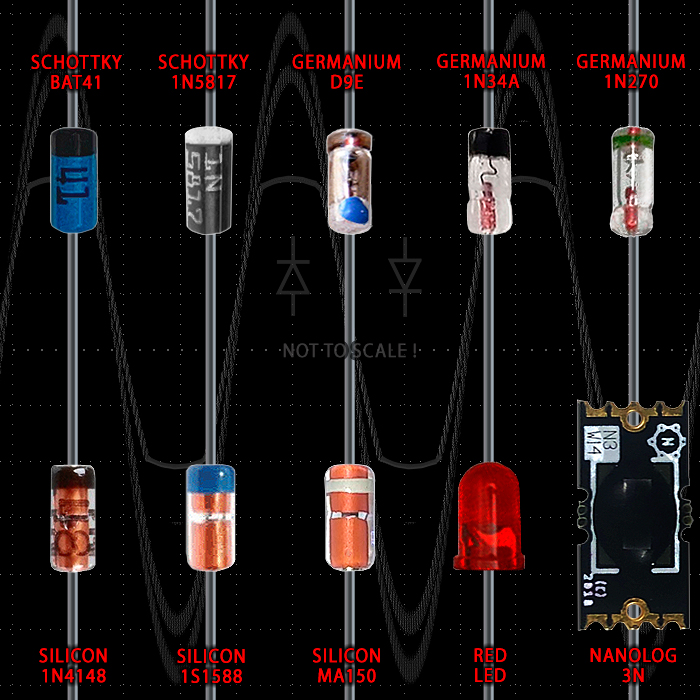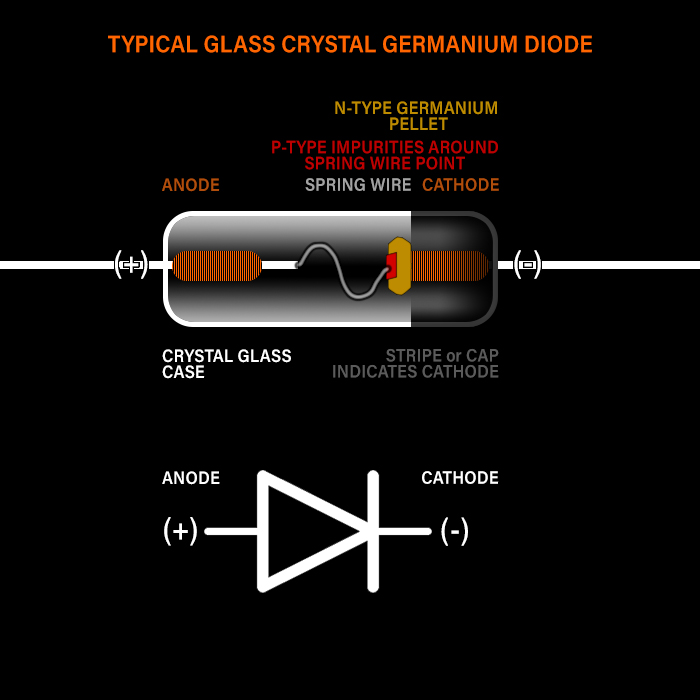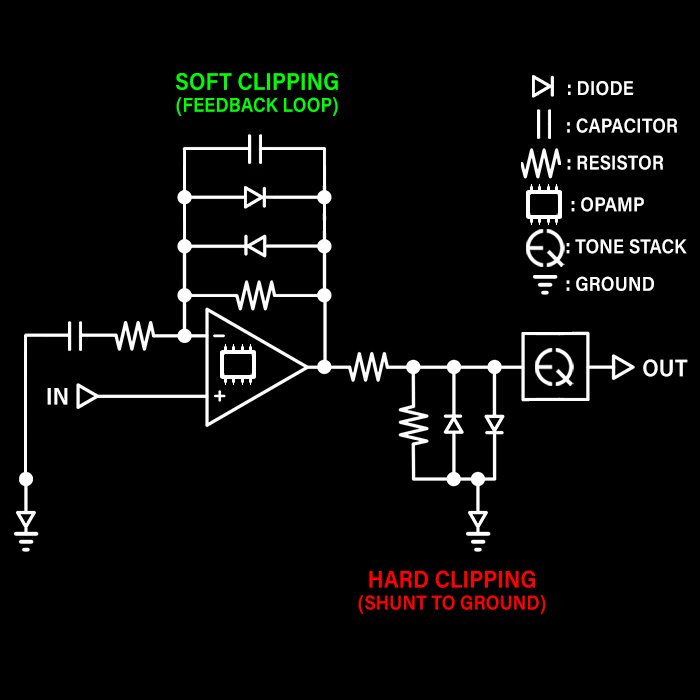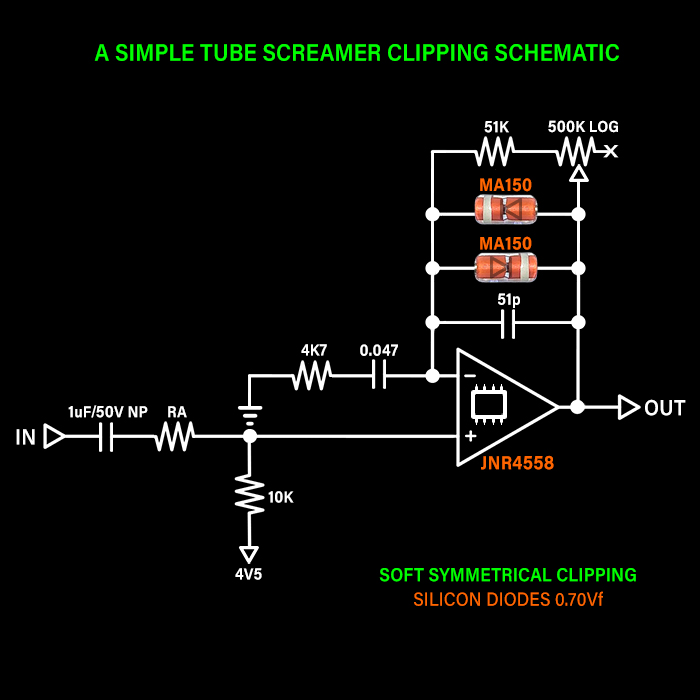A Brief Hobbyist Primer on Clipping Diodes
Blues Breaker Style OverdriveBlues Driver Style OverdriveBoost and OverdriveDistortionDriveDumble Style OverdriveFuzzGuitar Gear Improvements and PrototypesKlone and Transparent OverdriveMarshall Style DistortionOCD Style OverdriveOverdriveRat Style FuzzTubescreamer Style OverdriveVox Style Distortion+-

So this post came about due to my sometimes confusion between Soft and Hard Clipping, Symmetrical and Asymmetrical Clipping and the individual clipping characteristics of different Diodes. In my earliest pedal years I took the type of Diode to be the essential constituent of the clipping degree and texture versus the actual circuit and diodes arrangement. Phrases like ’Soft Clipping Germanium’ also confused me for eons - as it’s actually the methodology which principally defines the nature of the clipping, and in fact Germanium actually clips quite hard by default!
So this is largely a crib sheet as such to help me to remember the different fundamentals of Diode Clipping and exactly how they impact on the tone and texture of my favourite pedals’ circuits. I cover this in 5 key sections :
- Clipping Diode Introduction
- Soft vs Hard Diode Clipping
- Symmetrical vs Asymmetrical Clipping
- Notable Diode Clipping Circuits
- Notable Diodes and Use
Clipping Diode Introduction

Diodes are unidirectional electrical conductors and part of the Semiconductor family. Clipping Diodes are largely Junction Diodes or P-N Junction Diodes to be precise. They are typically made of Silicon, Germanium or Gallium Arsenide but there are a number of other different types employed too as we shall see.
For sake of example here we will be using a Glass Crystal Germanium Type reference roughly similar to a 1N34A. Here we can see all the key constituent parts of the device - copper-wire wrapped Cathode and Anode, the Germanium N-Type Pellet/Crystal with P-Type Impurities Area and the Fine Spring Wire bridging the gap.
The polarized Diodes devices act not entirely unlike resistors while they restrict and limit the current flow in one direction only. The nature of how the Positive P-Type and Negative N-Type areas interact results in a somewhat flawed behaviour which sort of triggers a gate-open type mechanic at certain Voltage values and results in some degree of spillover distortion. In fact a degree of capacitance occurs as electrons 'gather' on the P-Type surface until there are sufficient numbers to 'leap' / bridge the gap from the Cathode to the Anode.
The sufficient numbers of electrons or voltage threshold here is defined as Forward Voltage (Fv) or Voltage Drop and ranges from a median value of c0.25Vf for Schottky type diodes, through c0.35Vf for Germanium, c0.70Vf for Silicon and c2.0Vf for LEDs. The lower the value of Vf the greater the degree and onset of distortion.
Benoit of Coda Effects provides this handy guide :
- Schottky - Very High Distortion, Maximum Compression
- Germanium - High Distortion, Significant Compression
- Silicon - Classic/Standard Overdrive and Distortion - some degree of Compression
- LED - Very Open and Dynamic Saturation - Least Compression and Distortion
As with anything circuit based - it's how the core component is deployed which really matters - so you can 'soften' the clipping of a Diode by combining it with appropriate value capacitors and resistors, or stack them in series - evens (symmetrical) or odds (asymmetrical). The important takeaway here is that they are an organically functioning unidirectional limiting device whose flawed characteristics - in letting part of the current through are what makes them work for Pedal tone and harmonic texture generation.
I will be focusing on the manner of clipping enacted here rather than specific oscilloscope traces and patterns of output / waveforms - that will be for another feature - where I plot circuits by their waveform traces! Here I was somewhat surprised though to find that the softer clipping curves were the ones with more of the peak amplitudes 'lopped' off as such - in somehow producing a very softened/rounded looking almost square wave curve - but obviously with significantly lower amplitudes. What is important here though is therefore the angularity of the output waveforms and how high those peak - in terms of maximum distortion and vice versa.
Soft vs Hard Diode Clipping

This was initially a large part of my misunderstanding - as it is the actual circuit arrangement and deployment of the Diodes which is critical to the degree of clipping. In that Soft Clipping is achieved by applying the Diodes in the Feedback path / loop of the main tone-generator - typically OpAmp, while Hard Clipping occurs sequentially after the OpAmp and is achieved via routing the Diodes to ground - for maximum impact.
Soft Diode Clipping
This creates a more overdrive-like sound than 'Hard' clipping distortion. Two diodes are connected on the feedback-path / loop of an OpAmp or a Transistor. This rounds out the peaks of the signal - i.e. makes it 'softer' and provides a little more tube-like character to the tone. The Ibanez Tube Screamer uses this method as does the Paul Cochrane Timmy, and Hermida Zendrive even to a degree.
Hard Diode Clipping
A very common way to create distortion. Two diodes shunted to ground in opposite directions will cut away the peaks of the signal and thus, create distortion. The Boss DS-1, MXR Distortion+ and ProCo Rat are all excellent example of this type - as is actually the Klon Centaur too!
Symmetrical vs Asymmetrical Clipping

I always knew the impact of Symmetrical vs Asymmetrical clipping on those pedals which deployed those options, but I wasn't always familiar with the science and arrangement behind it. Generally to my ears Symmetrical Clipping is somewhat smoother, while Asymmetrical Clipping often produces a more textured and more appealing tonality. Say Boss OD-1 (Asymmetrical) vs Ibanez / Maxon 808.
Symmetrical Clipping
This occurs when you deploy even pairs of the same Diode in both directions. Most Symmetrical Clipping consists of a single pair of Diodes, while some use two pairs in series - so you have two Diodes on each directional branch / path of the circuit. Deploying two Diodes accumulates the Vf factor and renders a softer clipping. I've not seen many circuits with more than two Diodes per path as obviously you get increasing degrees of output loss too with excessive clipping. The Volume Drop experienced with most types of clipping really helps illustrate the Voltage Drop physics of the electronics. Undoubtedly the archetype for Symmetrical Clippers is the Ibanez / Maxon 808 overdrive.
Asymmetrical Clipping
So while Symmetrical usually means deploying even pairs, Asymmetrical means typically employing numerically odd sets or an additional Diode on just one of the directional paths - so you clip the output curve to different degrees north and south of the centre line. In most cases this means Two Diodes on one path vs One Diode in the other direction - while this could also be achieved by using just different Diodes with sufficiently different Vf values. For some reason the latter methodology is not particularly popular - where most go with 2 : 1. Classic Asymmetrical Clippers include the Boss OD-1 and SD-1 overdrives.
Notable Diode Clipping Circuits

Probably the most ubiquitous of all circuits - certainly of the Diode Clipping circuits - you have Ibanez's or Maxon's original green 808 Tube Screamer - with Soft Symmetrical Clipping courtesy of the JNR4558 OpAmp's Feedback Loop - as illustrated above. I took the opportunity to 'place' the very mojo Panasonic MA150 Diodes in situ here, while various iterations of Tube Screamer have variously used a number of different Diodes over the years - including the 1N4148, 1N914, and 1S1588 - all Silicon Diodes around the 0.7Vf mark!
Analog.Man King of Tone - Hybrid Dual Channel Symmetrical Soft-Clipping Overdrive which utilises 8 x Panasonic MA856 and 4x Toshiba 1S1588 Diodes on its different gain channels.
Boss OD-1 OverDrive - in many ways the forerunner to the Tube Screamer - deploys 1S1588 Diodes in Asymmetrical Soft Clipping arrangement.
Boss SD-1 Super OverDrive - a somewhat refinement and evolution of the OD-1 to a degree - Soft Asymmetrical Clipping with 1S2473 Diodes originally, and then IN4148.
Boss BD-2 Blues Driver - Hybrid / Hard Clipper - mix of Soft and Hard Symmetrical Clipping across 2 gain stages, uses 1SS133 Diodes and 1N914 Diodes.
Boss DS-1 Distortion - Famous Symmetrical Hard-Clipping Distortion uses 2 pairs of 1N4148.
Hermida Zendrive / Blues Breaker - The Zendrive actually utilises 2N7000 Mosfets as Symmetrical Soft-Clipping Diodes, while other notable Blues Breaker Circuits use a combination of Mosfets / and / or 1N4148 and BAT41 Diodes typically.
Klon Centaur - Notoriously misleading and complex Symmetrical Hard Clipping Overdrive which uses original USA-made 1N34A and D9E diodes. Lots of fakes / counterfeits on the market for these - so beware!
MXR Distortion+ - Symmetrical Hard Clipping Distortion which uses a pair of 1N34A Diodes.
Paul Cochrane Timmy - Actually at its core a Symmetrical Soft-Clipping Overdrive utilising 1N4148 Diodes, while it does obviously have an Asymmetrical clipping mode too.
ProCo Rat *Clipping - Obviously main distortion generator is LM308 type OpAmp and 1N914 Diodes, here I'm also referring to the latter mods for the Rat really - including the Dirty Rat's Germanium 1N34A Diodes and the now ubiquitous Turbo Rat's Two Red LEDs!
Clipping Diodes by Type with Typical Forward Voltage Ratings (Vf)

When I set off down this route I didn't expect this to become quite so complicated so quick. Frankly I find Transistors much easier to deal with. Turns out that Clipping Diodes have that exact same Mojo as Transformers where the 'authentic' original components used are the most sought-after but are in the shortest supply. Much the same as with Transistors many of these are now discontinued and out of production - while the market has been flooded with counterfeits as such - or near-looking equivalents which really aren't the same thing.
As with all mojo parts there are flaws and inconsistencies in the manufacturing process - as well as in the core function of these devices - so two from the same batch may be significantly different. That said you don't seem to have quite the same degree of quality variation as you do with Transistors.
Largely though the same approach applies here - where you really need to know the provenance of whom you're buying from - or it's unlikely to be the part you think it is. There are still lots of suitable alternatives in most guises - but certain mojo parts will still generate a richer, more harmonic and overall more appealing sound. Diodes are tempered by Capacitors and Resistors - and placing further ones in series. So there's lots of different ways you can deploy and 'tune' your Diodes. Finding exactly the right ones though can still be a struggle for some applications. And for many there are finite dwindling resources available! Exactly as per Transistors each Moho Diode needs to be inspected, measured and indexed individually.
Note that many Clipping Diodes have very little by way of official brand markers - while it's similar to the mojo Transistors - in that normally it's the local time-appropriate brands native to the original pedals which are considered the most authentic. So for Japanese pedals we're talking Pansonic and Toshiba, Gernany's Telefunken produced some excellent Germanium type Diodes, while for USA it's brands like NTE and Solid State. Obviously NOS Germanium Diodes - like their Transistor equivalents are very much on the point of unobtanium right now!
Schottky Silicon Diodes
Typical Forward Voltage - c0.25Vf
These specially engineered Silicon Diodes - named after German physicist Walter H. Schottky - were created to closely match Germanium Diode tolerances - and in fact go further - as these have typically the lowest rated Vf values - or as little as 0.15Vf in some instances. Note that these typically generate Very High Distortion with Maximum Compression - meaning they are often deployed serially in pairs to 'soften' their attack.
- BAT41 (0.36Vf) - Grey Matter, Zendrive
- BAT46 (0.25Vf)
- BAT48 (0.30Vf)
- BAT54 (0.32Vf)
- 1N5817 (0.25Vf)
- 1N5819 (0.26Vf)
Germanium Diodes
Typical Forward Voltage - 0.35Vf
Actually the most famous of the 'Hard Clipper' Diodes as seen and for their use on Distortion+ and Rat pedals in particular - but also the Klon Centaur. Germanium Clipping Diodes typically generate High Distortion with Significant Compression.
- AA116 (0.32Vf)
- AA138 (0.32Vf)
- AA143 (0.33Vf)
- D9E (0.257Vf) - Klon
- 1N34A (0.21Vf) - Distortion+, Klon, Rat
- 1N60P (0.33Vf)
- 1N270 (0.268Vf) - Grey Matter
- 1N276 (0.35Vf)
- 1N277 (0.37Vf)
Silicon Diodes
Typical Forward Voltage - c0.70Vf
These are generally rather tiny devices although split into Small Signal Diodes, and slightly bigger Power Diodes. You can see by how close the copper-wound Anodes and Cathodes are to the glass shell exteriors compared to the Germanium Diode equivalents which are many times the size of these tiny Silicon Diodes - I have pictured them at the same size for purely visual comparative purposes for their internal component parts. These obviously form the mainstay of Clipping Diodes as we know them and are core to many of our favourite Soft Clipping Overdrives. Silicon generally provides moderate degrees of Clipping Distortion with fairly Minimal Compression.
- 1N4001 (0.45Vf)
- 1N414 (0.62Vf) - DS-1
- 1N4148 (0.68Vf) - Blues Breaker, DS-1, Timmy, TS808
- 1N4448 (0.62Vf) - Rat
- 1N4733A (0.78Vf)
- 1N914 (0.68Vf) - Blues Driver, Rat, TS808
- 1N916 (0.63Vf) - Rat
- 1S1588 (0.571Vf)- KOT, OD-1, TS808
- 1S2473 (0.67Vf)- OD-1, SD01
- 1SS133 (0.65Vf) - Blues Driver
- MA150 (0.70Vf) - TS808
- MA856 (0.685Vf) - KOT
LED Diodes
Typical Forward Voltage - 1.2 > 4.0Vf
Obviously the ubiquitous 2 Red LEDs is well known here - being around 1.7Vf - but LEDs can range to at least twice that across the spectrum. Not all bulbs have tonally unique Vf signatures - and there are many variations within Hue and type which yield significant difference. I'm very familiar with this courtesy of a number of my Rat Pedals, but a also Redbeard Effects' Red Mist MKIV Distortion and Kuro Custom Audio's P.h.A. Overdrive most recently. The higher Vf range of LEDs produces Very Open and Dynamic Saturation accompanied by the Least amount of Compression and Distortion overall of any of these Clipping Diode Types. The way how LED clipping onset happens rather late in the gain cycle and ever so smoothly is very well used in all these pedals. This is a great organic and subtle way to apply additional saturation to most circuits.
- Infra Red (1.2Vf)
- Red (1.7Vf) - P.h.A., Red Mist, Rat
- Orange (2.0Vf)
- Yellow (2.1Vf)
- Green (2.2Vf)
- Blue (3.2Vf)
- White (3.3Vf)
- Pink (3.3Vf)
- Purple (3.3Vf)
- Aqua (3.4Vf)
- Ultra Violet (3.8Vf)
FET / JFET / MOSFET Transistors as Clipping Diodes
Typical Forward Voltage c0.70Vf
FETs of various types can be used as Clipping Diodes too to a degree - like in the Hermida Zendrive. Their Vf range is pretty similar to core Silicon, while the texture of distortion is somewhat softer in many ways. By and large the use of these can be seen as relatively similar in impact to Silicon variants.
BS170 (0.581Vf)
2N5457 (0.696Vf)
2N7000 (0.600Vf) Fulltone OCD, Hermida Zendrive
Germanium Transistors as Clipping Diodes
Typical Forward Voltage c0.19Vf
Transistors can similarly be deployed as Clipping Diodes in certain circumstances - and these generally give you an unprecedented degree of harmonic texture - Distortion and Compression wise - these are very close to the Schottky varieties - with slightly different character though.
AC128 (0.19Vf)
OC44 (0.16Vf)
2N527 (0.19Vf)
Nanolog Molecular Diodes
These likely came to most people's attentions courtesy of Dr Scientists's Heisenberg Molecular Overdrive - now discontinued - but the legend is carried forward in Nanolog's own Carbon Series Classic Overdrive which mixes up 4 clipping varieties - Germanium, Silicon - and it's own N1 and N2 Molecular Junction Devices.
An entirely new technology which achieves the core Diode function via Layers of Carbon molecules - between 1 and 10 nanometers thick. These render somewhat more controllable and evenly balanced Vf curves - albeit Forward Voltage rates are not quoted here for some reason. There are currently 3 Nanolog Molecular Diode Devices - simply named N1 to N3 - and described as follows:
- N1 - The most saturated/compressed of the three. Use this if the goal is to get a similar sound to silicon or germanium but with improved dynamics and clarity
- N2 - The most popular option. Great dynamic range and warm/natural compression. Perhaps the most 'tube-like' in the right circuit
- N3 - The most headroom. Huge dynamic range, rich low end, and overall powerful presence
General Advisory and References
This is very much a 'hobbyist' guide in that I've not taken it upon myself to measure independently and verify all the Vf figures I'm quoting here - these are simply derived from a variety of key resources on the web. This is your basic 101 guide to Diodes and I wrote this largely for my own purposes - in order to have some sort of handy record and reference to Clipping Diodes as I do occasionally still get confused! Reader discretion advised!
I found the following resources particularly handy :
I also scoured hundreds of different message board threads and other web references for details - far too many and far too fragmented to report here!
I hope that some of you might find some of this useful!
from Hacker News https://ift.tt/9JfISk6
No comments:
Post a Comment
Note: Only a member of this blog may post a comment.